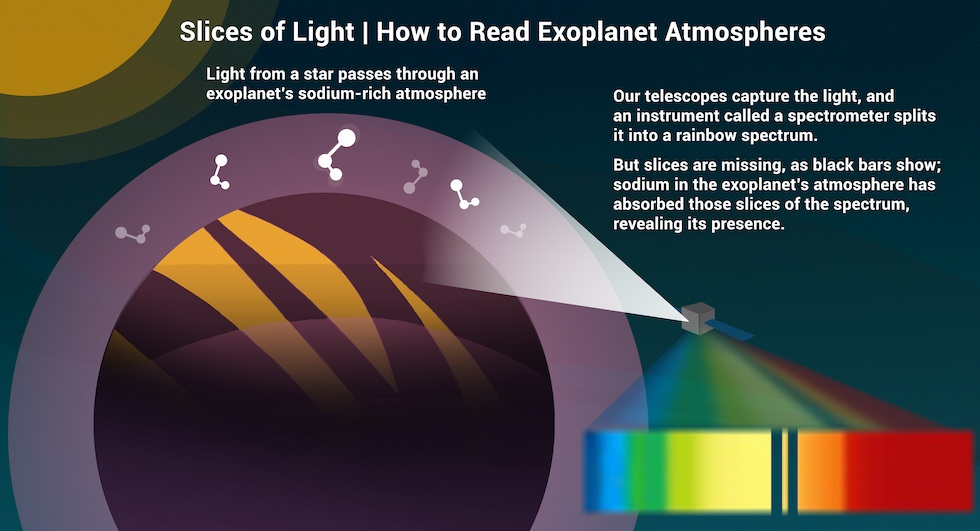Life on Earth depends on six critical elements: Carbon, Hydrogen, Nitrogen, Oxygen, Phosphorous, and Sulfur. These elements are referred to as CHNOPS, and along with several trace micronutrients and liquid water, they’re what life needs.
Scientists are getting a handle on detecting exoplanets that might be warm enough to have liquid water on their surfaces, habitability’s most basic signal. But now, they’re looking to up their game by finding CHNOPS in exoplanet atmospheres.
We’re only at the beginning of understanding how exoplanets could support life. To grow our understanding, we need to understand the availability of CHNOPS in planetary atmospheres.
A new paper examines the issue. It’s titled “Habitability constraints by nutrient availability in atmospheres of rocky exoplanets.” The lead author is Oliver Herbort from the Department of Astrophysics at the University of Vienna and an ARIEL post-doctoral fellow. The paper has been accepted by the International Journal of Astrobiology.
At our current technological level, we’re just beginning to examine exoplanet atmospheres. The JWST is our main tool for the task, and it’s good at it. But the JWST is busy with other tasks. In 2029, the ESA will launch ARIEL, the Atmospheric Remote-sensing Infrared Exoplanet Large survey. ARIEL will be solely focused on exoplanet atmospheres.

In anticipation of that telescope’s mission, Herbort and his co-researchers are preparing for the results and what they mean for habitability. “The detailed understanding of the planets itself becomes important for interpreting observations, especially for the detection of biosignatures,” they write. In particular, they’re scrutinizing the idea of aerial biospheres. “We aim to understand the presence of these nutrients within atmospheres that show the presence of water cloud condensates, potentially allowing the existence of aerial biospheres.”
Our sister planet Venus has an unsurvivable surface. The extreme heat and pressure make the planet’s surface uninhabitable by any measure we can determine. But some scientists have proposed that life could exist in Venus’ atmosphere, based largely on the detection of phosphine, a possible indicator of life. This is an example of what an aerial biosphere might look like.

“This concept of aerial biospheres enlarges the possibilities of potential habitability from the presence of liquid water on the surface to all planets with liquid water clouds,” the authors explain.
The authors examined the idea of aerial biospheres and how the detection of CHNOPS plays into them. They introduced the concept of nutrient availability levels in exoplanet atmospheres. In their framework, the presence of water is required regardless of other nutrient availability. “We considered any atmosphere without water condensates as uninhabitable,” they write, a nod to water’s primacy. The researchers assigned different levels of habitability based on the presence and amounts of the CHNOPS nutrients.

To explore their framework of nutrient availability, the researchers turned to simulations. The simulated atmospheres held different levels of nutrients, and the researchers applied their concept of nutrient availability. Their results aim to understand not habitability but the chemical potential for habitability. A planet’s atmosphere can be altered drastically by life, and this research aims to understand the atmospheric potential for life.
“Our approach does not directly aim for the understanding of biosignatures and atmospheres of planets, which are inhabited, but for the conditions in which pre-biotic chemistry can occur,” they write. In their work, the minimum atmospheric concentration for a nutrient to be available is 10?9, or one ppb (part per billion.)
“We find that for most atmospheres at ( p gas, T gas) points, where liquid water is stable, CNS-bearing molecules are present at concentrations above 10?9,” they write. They also found that carbon is generally present in every simulated atmosphere and that sulphur availability increases with surface temperature. With lower surface temperatures, nitrogen (N2, NH3) is present in increasing amounts. But with higher surface temperatures, nitrogen can become depleted.
Phosphorus is a different matter. “The limiting element of the CHNOPS elements is phosphorus, which is mostly bound in the planetary crust,” they write. The authors point out that, at past times in Earth’s atmosphere, phosphorus scarcity limited the biosphere.
An aerial biosphere is an interesting idea. But it’s not the main thrust of scientists’ efforts to detect exoplanet atmospheres. Surface life is their holy grail. It should be no surprise that it still comes down to liquid water, all things considered. “Similar to previous work, our models suggest that the limiting factor for habitability at the surface of a planet is the presence of liquid water,” the authors write. In their work, when surface water was available, CNS was available in the lower atmosphere near the surface.
But surface water plays several roles in atmospheric chemistry. It can bond with some nutrients in some circumstances, making them unavailable, and in other circumstances, it can make them available.
“If water is available at the surface, the elements not present in the gas phase are stored in the crust condensates,” the authors write. Chemical weathering can then make them available as nutrients. “This provides a pathway to overcome the lack of atmospheric phosphorus and metals, which are used in enzymes that drive many biological processes.”

This complicates matters on worlds covered by oceans. Pre-biotic molecules might not be available if there’s no opportunity for water and rock to interact with the atmosphere. “If indeed it can be shown that life can form in a water ocean without any exposed land, this constraint becomes weaker, and the potential for the surface habitability becomes mainly a question of water stability,” the authors write.
Some of the models are surprising because of atmospheric liquid water. “Many of the models show the presence of a liquid water zone in the atmospheres, which is detached from the surface. These regions could be of interest for the formation of life in forms of aerial biospheres,” Herbort and his colleagues write.
If there’s one thing that research like this shows, planetary atmospheres are extraordinarily complex and can change dramatically over time, sometimes because of life itself. This research makes some sense in trying to understand it all. Emphasizing the complexity is the fact that the researchers didn’t include stellar radiation in their work. Including that would’ve made the effort unwieldy.
The habitability issue is complicated, confounded by our lack of answers to foundational questions. Does a planet’s crust have to be in contact with water and the atmosphere for the CHNOPS nutrients to be available? Earth has a temporary aerial biosphere. Can aerial biospheres be an important part of exoplanet habitability?
But beyond all the simulations and models, as powerful as they are, what scientists need most is more data. When ARIEL launches, scientists will have much more data to work with. Research like this will help scientists understand what ARIEL finds.

